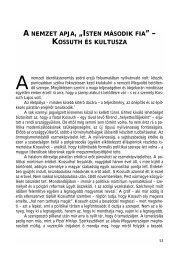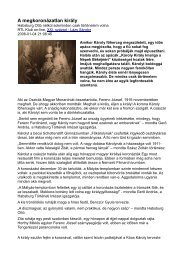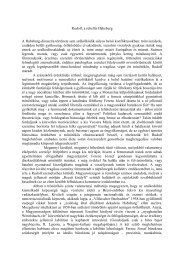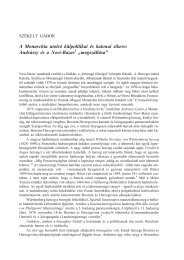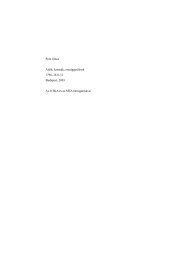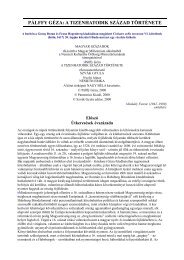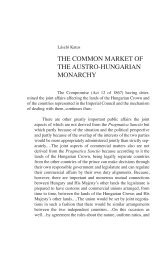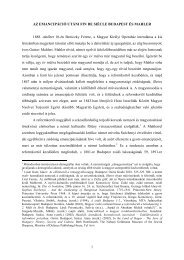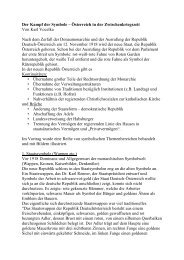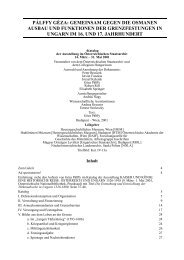introduction: hungary and the habsburgs in the early modern period
introduction: hungary and the habsburgs in the early modern period
introduction: hungary and the habsburgs in the early modern period
Create successful ePaper yourself
Turn your PDF publications into a flip-book with our unique Google optimized e-Paper software.
CHAPTER ONE<br />
INTRODUCTION: HUNGARY<br />
AND THE HABSBURGS IN<br />
THE EARLY MODERN PERIOD<br />
Prejudices <strong>and</strong> Debatable Interpretations<br />
The way <strong>in</strong> which <strong>the</strong> sixteenth <strong>and</strong> seventeenth century<br />
relations of <strong>the</strong> Habsburg Monarchy <strong>and</strong> <strong>the</strong> K<strong>in</strong>gdom of Hungary<br />
were viewed changed significantly after <strong>the</strong> first half of <strong>the</strong> n<strong>in</strong>eteenth<br />
century. Modern Hungarian historiography came <strong>in</strong>to existence <strong>in</strong> <strong>the</strong><br />
eighteenth century. Its first practitioners were <strong>in</strong>fluenced by <strong>the</strong> contemporary<br />
Habsburg state <strong>in</strong> which <strong>the</strong>y lived. The appearance of <strong>the</strong><br />
nation-states <strong>and</strong> of <strong>the</strong> concept of national <strong>in</strong>dependence brought<br />
major changes. The historical concept of <strong>in</strong>dependence became <strong>the</strong><br />
major trend <strong>in</strong> Hungarian historiography dur<strong>in</strong>g <strong>the</strong> last third of <strong>the</strong><br />
n<strong>in</strong>eteenth century. Its role is still important today <strong>and</strong> was particularly<br />
important dur<strong>in</strong>g certa<strong>in</strong> earlier <strong>period</strong>s. It was accepted equally by<br />
Catholic <strong>and</strong> Protestant historians, by positivists just as much as by <strong>the</strong><br />
historians of ideas, by Marxists <strong>and</strong> by <strong>the</strong> partisans of <strong>the</strong> national<br />
romanticism of our day. 1<br />
A solid basis was laid down, dur<strong>in</strong>g <strong>the</strong> second half of <strong>the</strong> n<strong>in</strong>eteenth<br />
century, by <strong>the</strong> romantic nationalist historians. 2 They uncovered<br />
enormous archival material but assessed it from <strong>the</strong> perspective of <strong>the</strong><br />
political situation <strong>and</strong> <strong>in</strong>dependist ideology of <strong>the</strong> times. The pr<strong>in</strong>cipal<br />
representatives of this approach were <strong>the</strong> Protestant Kálmán Thaly<br />
(1839–1909) <strong>and</strong> <strong>the</strong> leader of <strong>the</strong> Viennese research group, Sándor
2 THE KINGDOM OF HUNGARY AND THE HABSBURG MONARCHY<br />
Takáts (1860–1932), a Piarist priest. The former published a number of<br />
volumes of source material on <strong>the</strong> activities of Imre Thököly <strong>and</strong><br />
Ferenc II Rákóczi but, as a lead<strong>in</strong>g member of <strong>the</strong> Independence Party,<br />
<strong>the</strong> concepts of national <strong>in</strong>dependence dom<strong>in</strong>ated his historiography.<br />
Thus, he even published historical poems which he forged himself.<br />
Takáts was one of <strong>the</strong> greatest experts on <strong>the</strong> contents of <strong>the</strong> Vienna<br />
archives. He was firmly anti-Habsburg <strong>and</strong> thus <strong>in</strong> his essays, written<br />
<strong>in</strong> an enjoyable style, he generally endeavored to show <strong>the</strong> anti-Hungary<br />
sentiments of <strong>the</strong> Vienna court. In <strong>the</strong> absence of more recent<br />
<strong>in</strong>vestigations, <strong>the</strong>ir writ<strong>in</strong>gs were used frequently dur<strong>in</strong>g <strong>the</strong> decades<br />
after World War II <strong>and</strong> are of importance even today. The perspectives<br />
of Thaly <strong>and</strong> Takáts were based on <strong>the</strong>ir firm resolve to engage <strong>in</strong><br />
extended polemics with <strong>the</strong>ir Austrian historian colleagues who represented<br />
a dynastic-imperial perspective.<br />
In writ<strong>in</strong>g <strong>the</strong> history of <strong>the</strong> mult<strong>in</strong>ational K<strong>in</strong>gdom of Hungary <strong>in</strong><br />
<strong>the</strong> <strong>early</strong> <strong>modern</strong> era not every historian subscribed to <strong>the</strong> concepts of<br />
national <strong>in</strong>dependence, even when romantic nationalism was at its<br />
peak. 3 Ignác Acsády (1853–1906), who summarized <strong>the</strong> history of <strong>the</strong><br />
sixteenth century for <strong>the</strong> 1896 millennium of <strong>the</strong> Hungarian conquest,<br />
or Árpád Károlyi (1853–1940), who was ano<strong>the</strong>r great expert on <strong>the</strong><br />
Vienna archives were more careful <strong>in</strong> <strong>the</strong>ir presentations. 4 An even<br />
stronger position was taken <strong>in</strong> his Magyar történet by <strong>the</strong> most noted<br />
Hungarian historian of <strong>the</strong> first half of <strong>the</strong> twentieth century, Gyula<br />
SzekfŠ (1883–1955), even though <strong>in</strong> his historiographical works, stress<br />
on <strong>the</strong> nation-state perspective could be noticed. After several years of<br />
research <strong>in</strong> <strong>the</strong> Viennese archives <strong>and</strong> on <strong>the</strong> basis of <strong>the</strong> sources concern<strong>in</strong>g<br />
<strong>the</strong> K<strong>in</strong>gdom of Hungary, he concluded that <strong>the</strong> sixteenth- <strong>and</strong><br />
seventeenth-century activities of <strong>the</strong> Habsburgs vis-à-vis Hungary<br />
could not be summarily condemned. Accord<strong>in</strong>g to SzekfŠ, <strong>the</strong> Habsburgs,<br />
<strong>in</strong> cooperation with <strong>the</strong> Hungarian l<strong>and</strong>owner nobility, played an<br />
important role <strong>in</strong> <strong>the</strong> protection of <strong>the</strong> K<strong>in</strong>gdom of Hungary aga<strong>in</strong>st <strong>the</strong><br />
Ottomans. 5 Because of this view SzekfŠ was severely criticized by his<br />
romantic nationalist colleagues <strong>and</strong> by <strong>the</strong> major representatives of <strong>the</strong><br />
post-1950 historians. It was thus that SzekfŠ was classified with <strong>the</strong><br />
“bourgeois, pro-Habsburg falsifiers of history.” In <strong>the</strong>se debates <strong>the</strong><br />
primary considerations were not <strong>the</strong> appropriateness of <strong>the</strong> sources but<br />
<strong>the</strong> virulent prejudices of <strong>the</strong> <strong>period</strong> <strong>and</strong> <strong>the</strong> nationalist illusions.
INTRODUCTION: THE EARLY MODERN PERIOD 3<br />
The above epi<strong>the</strong>t came from Aladár Mód (1908–1973), one of <strong>the</strong><br />
most unusual figures of <strong>the</strong> national <strong>in</strong>dependence concept <strong>and</strong> <strong>the</strong><br />
“fa<strong>the</strong>r” of Hungarian “scientific socialism.” In his celebrated, romantic<br />
nationalist monograph, 400 év küzdelem az önálló Magyarországért, he<br />
offered an <strong>in</strong>terpretation of history that reflected <strong>the</strong> political ideology of<br />
his times. 6 The work presents <strong>the</strong> jo<strong>in</strong>t history of <strong>the</strong> Hungarian state <strong>and</strong><br />
<strong>the</strong> Habsburgs, from 1526 to 1918, as a fight for Hungarian <strong>in</strong>dependence<br />
aga<strong>in</strong>st <strong>the</strong> “German oppressors,” <strong>the</strong> “Austrian colonizers” <strong>and</strong> <strong>the</strong><br />
”imperialist” Habsburgs. The leaders of this struggle on <strong>the</strong> Hungarian<br />
side were <strong>the</strong> pr<strong>in</strong>ces of Transylvania. The work, first published <strong>in</strong> 1943,<br />
was written <strong>in</strong> opposition to German fascism. In a number of significantly<br />
enlarged <strong>and</strong> modified editions, after <strong>the</strong> 1950s, it became, <strong>in</strong> support<br />
of communist propag<strong>and</strong>a, an attack aga<strong>in</strong>st German imperialism <strong>and</strong><br />
aga<strong>in</strong>st <strong>the</strong> Habsburgs. In this era, <strong>the</strong> work was very effective. It focused<br />
on a few of <strong>the</strong> critical <strong>period</strong>s <strong>in</strong> <strong>the</strong> history of <strong>the</strong> Habsburgs <strong>and</strong> <strong>the</strong><br />
Hungarians, such as <strong>the</strong> Bocskai upris<strong>in</strong>g (1604–1606), <strong>the</strong> Rákóczi War<br />
of Independence (1703–1711), <strong>and</strong> <strong>the</strong> 1848–49 Revolution <strong>and</strong> War of<br />
Independence <strong>and</strong> superimposed <strong>the</strong> problems of <strong>the</strong>se limited time <strong>period</strong>s<br />
to <strong>the</strong> entire four centuries of <strong>the</strong> Habsburg-Hungarian relations. He<br />
assessed <strong>the</strong> history of Hungary <strong>in</strong> <strong>the</strong> <strong>early</strong> <strong>modern</strong> era <strong>in</strong> <strong>the</strong> spirit of <strong>the</strong><br />
prevail<strong>in</strong>g political ideology of his times, without hav<strong>in</strong>g done any basic<br />
research <strong>and</strong> ignor<strong>in</strong>g <strong>the</strong> fundamental pr<strong>in</strong>ciples of his craft. Even<br />
though <strong>the</strong> work is now rarely read by students, its effects on historical<br />
perspectives are still very much alive.<br />
The <strong>in</strong>fluence of <strong>the</strong> politics <strong>and</strong> ideology of <strong>the</strong> 1950s <strong>and</strong> 1960s<br />
on Hungarian historiography was so profound that even <strong>the</strong> most significant<br />
researcher of <strong>the</strong> history of Hungarian adm<strong>in</strong>istration, GyŒzŒ<br />
Ember (1909–1993), accepted <strong>the</strong> view that <strong>the</strong> Habsburgs impeded <strong>the</strong><br />
evolution of <strong>the</strong> Hungarian nation <strong>in</strong> <strong>the</strong> <strong>early</strong> <strong>modern</strong> era. 7 This perspective<br />
resulted, between <strong>the</strong> 1950s <strong>and</strong> 1970s, <strong>in</strong> a very selective use<br />
of <strong>the</strong> sources <strong>and</strong> consequently led to an idiosyncratic selection of topics<br />
<strong>and</strong> a tendentious assessment of <strong>the</strong> source material. The debates <strong>in</strong><br />
<strong>the</strong> 1960s on <strong>the</strong> issues of nationalism, firmly attached to <strong>the</strong> name of<br />
Erik Molnár, testify to <strong>the</strong> contradictions <strong>in</strong>separable from this perspective.<br />
8 Yet, <strong>the</strong>se discussions resulted <strong>in</strong> a number of <strong>in</strong>ternationally<br />
important professional results such as <strong>the</strong> surveys, spann<strong>in</strong>g this entire<br />
<strong>period</strong>, published by JenŒ SzŠcs (1928–1988). 9
4 THE KINGDOM OF HUNGARY AND THE HABSBURG MONARCHY<br />
Consequently, <strong>the</strong> majority of <strong>the</strong> historical surveys, written dur<strong>in</strong>g<br />
<strong>the</strong> twenty-five years after World War II, could say little new about<br />
<strong>the</strong> activities of <strong>the</strong> K<strong>in</strong>gdom of Hungary, ruled by <strong>the</strong> Habsburgs,<br />
when compared to <strong>the</strong> important summaries of <strong>the</strong> n<strong>in</strong>eteenth <strong>and</strong><br />
twentieth centuries. 10 For this reason, such works largely discussed <strong>the</strong><br />
confrontation of <strong>the</strong> Habsburgs with <strong>the</strong> Transylvanian pr<strong>in</strong>ces who<br />
conducted <strong>the</strong>ir own foreign policy. Accord<strong>in</strong>g to <strong>the</strong>se works, <strong>the</strong>se<br />
pr<strong>in</strong>ces, particularly István Bocskai, Gábor Bethlen, <strong>and</strong> Imre Thököly<br />
fought for an “<strong>in</strong>dependent Hungary,” albeit with <strong>the</strong> help of several<br />
thous<strong>and</strong> Ottoman <strong>and</strong> Tatar troops. 11 Official policies consistently<br />
supported this dubious concept. This was demonstrated vividly to <strong>the</strong><br />
public when dur<strong>in</strong>g <strong>the</strong> first half of <strong>the</strong> 1950s when <strong>the</strong> statues of <strong>the</strong><br />
Habsburg rulers (Ferd<strong>in</strong><strong>and</strong> I, Charles III, Maria Theresa, Leopold II,<br />
<strong>and</strong> Francis Joseph) <strong>in</strong> <strong>the</strong> Hungarian royal pan<strong>the</strong>on on Heroes’<br />
Square <strong>in</strong> Budapest were replaced by <strong>the</strong> statues of István Bocskai,<br />
Gábor Bethlen, Imre Thököly, Ferenc II Rákóczi, <strong>and</strong> Lajos Kossuth. 12<br />
Ano<strong>the</strong>r method for <strong>the</strong> schematic assessment of <strong>the</strong> Habsburgs’<br />
Hungarian policies was to show <strong>the</strong>ir opposition to <strong>the</strong> freedom fight<br />
<strong>and</strong> state of Ferenc II Rákóczi, who conducted an armed struggle for<br />
<strong>in</strong>dependence. The survey by Ágnes R. Várkonyi (b. 1928), Két pogány<br />
közt: A Rákóczi-szabadságharc története, revealed this method vividly<br />
<strong>in</strong> four successive editions. 13 This volume was one of <strong>the</strong> most popular<br />
works dur<strong>in</strong>g <strong>the</strong> 1970s <strong>and</strong> 1980s for <strong>the</strong> students <strong>in</strong>terested <strong>in</strong> <strong>the</strong> history<br />
of <strong>the</strong> <strong>early</strong> <strong>modern</strong> era, <strong>in</strong>clud<strong>in</strong>g <strong>the</strong> author of <strong>the</strong> present volume.<br />
It was decisive <strong>in</strong> establish<strong>in</strong>g <strong>the</strong> view of history for <strong>the</strong> present<br />
younger generation. It was thus that <strong>the</strong> Habsburgs, who wore <strong>the</strong> royal<br />
crown of Hungary just as legitimately as did <strong>the</strong> Italian Angev<strong>in</strong>es or<br />
<strong>the</strong> Polish Jagiellos, were transformed <strong>in</strong>to conquerors just like <strong>the</strong><br />
Ottomans who had <strong>in</strong> fact conquered one third of <strong>the</strong> country with<br />
armed forces.<br />
Dur<strong>in</strong>g <strong>the</strong> 1960s to 1980s <strong>the</strong> studies first of Kálmán Benda<br />
(1913–1994) <strong>and</strong> László Makkai (1914–1989) <strong>and</strong> later of László<br />
Benczédi (1929–1986), Katal<strong>in</strong> Péter (b. 1937), Ferenc Szakály (1942–<br />
1999), <strong>and</strong> Imre Szántó (1920–1993) significantly modified <strong>the</strong> earlier<br />
perspective. 14 Yet, even <strong>the</strong>n, <strong>the</strong> Hungarian policies of <strong>the</strong> Habsburgs<br />
<strong>and</strong> <strong>the</strong> activities of <strong>the</strong> k<strong>in</strong>gdom were rarely studied on <strong>the</strong> basis of <strong>the</strong><br />
resources <strong>in</strong> <strong>the</strong> Vienna <strong>and</strong> Budapest archives. New <strong>in</strong>vestigations
INTRODUCTION: THE EARLY MODERN PERIOD 5<br />
focused primarily on <strong>the</strong> resistance of <strong>the</strong> Hungarian estates aga<strong>in</strong>st <strong>the</strong><br />
centralist or absolutist activities of <strong>the</strong> rulers <strong>and</strong> on <strong>the</strong> various anti-<br />
Habsburg movements. In this context, <strong>the</strong> students of political <strong>and</strong><br />
adm<strong>in</strong>istrative history spent most of <strong>the</strong>ir time analyz<strong>in</strong>g <strong>the</strong> rule of<br />
János (John) Szapolyai, <strong>the</strong> evolution of <strong>the</strong> Transylvanian pr<strong>in</strong>cipality<br />
<strong>and</strong>, first <strong>and</strong> foremost, <strong>the</strong> anti-Habsburg campaigns of <strong>the</strong> Transylvanian<br />
pr<strong>in</strong>ces. 15 The selection of topics relative to <strong>the</strong> Habsburgs <strong>and</strong><br />
<strong>the</strong> K<strong>in</strong>gdom of Hungary was still frequently one-sided <strong>in</strong> spite of <strong>the</strong><br />
lessen<strong>in</strong>g of <strong>the</strong> ideological pressures. In both spirit <strong>and</strong> professionalism<br />
<strong>the</strong> three volume history of Transylvania can be considered to be a<br />
major achievement. 16<br />
After <strong>the</strong> 1980s, <strong>the</strong> anachronistic historical <strong>the</strong>me of national <strong>in</strong>dependence<br />
was gradually replaced by <strong>the</strong> <strong>the</strong>ory of <strong>the</strong> national unification<br />
attempts which orig<strong>in</strong>ated <strong>in</strong> Transylvania. This approach is clear <strong>in</strong><br />
<strong>the</strong> most significant undertak<strong>in</strong>g of postwar Hungarian historiography,<br />
<strong>the</strong> ten-volume history of Hungary. The two volumes deal<strong>in</strong>g with <strong>the</strong><br />
<strong>period</strong> between 1526 <strong>and</strong> 1686 no longer speak of an <strong>in</strong>dependent Hungary,<br />
not even <strong>in</strong> a discussion on Transylvania. The pr<strong>in</strong>ces are <strong>in</strong>volved<br />
only <strong>in</strong> ”anti-Habsburg struggles” <strong>and</strong> “national unification endeavors”<br />
<strong>and</strong> no longer <strong>in</strong> fights for freedom or national <strong>in</strong>dependence movements.<br />
17 This view was rejected sharply by Ferenc Szakály, one of <strong>the</strong><br />
greatest experts on <strong>the</strong> <strong>in</strong>ternal matters of <strong>the</strong> k<strong>in</strong>gdom. 18 In spite of this<br />
<strong>the</strong> above concepts cont<strong>in</strong>ue to be very much alive.<br />
Yet, even after World War II not every Hungarian historian <strong>in</strong>terpreted<br />
<strong>the</strong> history of <strong>the</strong> K<strong>in</strong>gdom of Hungary <strong>in</strong> <strong>the</strong> <strong>early</strong> <strong>modern</strong> era<br />
from <strong>the</strong> perspective of <strong>the</strong> anti-Habsburg movements or national <strong>in</strong>dependence.<br />
In addition to <strong>the</strong> economic historians to be discussed below,<br />
we must particularly recognize Éva H. Balázs (1915–2006), Domokos<br />
Kosáry (1913–2007), Ferenc Szakály, <strong>and</strong> JenŒ SzŠcs as well as <strong>the</strong><br />
Hungarian Osmanists who always thought <strong>in</strong> terms of <strong>in</strong>ternational<br />
relations. 19 While H. Balázs <strong>and</strong> Kosáry assessed <strong>the</strong> eighteenth century<br />
Habsburg-Hungarian relationships <strong>and</strong> cultural matters from a new<br />
perspective, Szakály studied <strong>the</strong> role of <strong>the</strong> Hungarian large estate owners<br />
<strong>and</strong> <strong>the</strong> Hungarian history of <strong>the</strong> sixteenth <strong>and</strong> seventeenth centuries.<br />
20 JenŒ SzŠcs, <strong>in</strong> his overarch<strong>in</strong>g historical essay <strong>in</strong> 1983, made<br />
dar<strong>in</strong>g statements like, “The dreams beg<strong>in</strong> by say<strong>in</strong>g that <strong>the</strong> Habsburgs<br />
might have been forestalled….They cont<strong>in</strong>ue by stat<strong>in</strong>g that <strong>the</strong>re
6 THE KINGDOM OF HUNGARY AND THE HABSBURG MONARCHY<br />
was an idea of some k<strong>in</strong>d of ‘national absolutism’ at work <strong>in</strong> depths of<br />
anti-Habsburg movements. They end by conclud<strong>in</strong>g that <strong>the</strong>se movements<br />
would have achieved some freedom for <strong>the</strong> serfs.” 21 Even <strong>the</strong><br />
most ardent representatives of <strong>the</strong> <strong>in</strong>dependence perspective of <strong>the</strong><br />
1950s–1970s significantly modified <strong>the</strong>ir earlier views. 22<br />
The works prepared <strong>in</strong> a European framework after <strong>the</strong> 1980s contributed<br />
substantially to <strong>the</strong> beg<strong>in</strong>n<strong>in</strong>gs of a gradual reassessment of <strong>the</strong><br />
Habsburg <strong>and</strong> Hungarian relations. The <strong>in</strong>dependence concept, based on<br />
solid n<strong>in</strong>eteenth century traditions resulted <strong>in</strong> <strong>the</strong> fact that <strong>the</strong> post-1526<br />
Habsburg rule of Hungary is given, even today, a biased <strong>in</strong>terpretation.<br />
This view becomes less frequent <strong>in</strong> <strong>the</strong> professional monographs <strong>and</strong> is<br />
seen primarily <strong>in</strong> works on <strong>the</strong> seventeenth century <strong>and</strong> on <strong>the</strong> Rákóczi<br />
War of Independence. 23 The long range effects of <strong>the</strong> national <strong>in</strong>dependence<br />
perspective of <strong>the</strong> 1950s–1970s Hungarian historiography can be<br />
seen cl<strong>early</strong> <strong>in</strong> <strong>the</strong> Hungarian historical summaries of Paul Lendvai (b.<br />
1929), <strong>the</strong> Austrian journalist of Hungarian descent. The chapter <strong>in</strong>troduc<strong>in</strong>g<br />
<strong>the</strong> reader to Transylvania is entitled, anachronistically <strong>in</strong> 2003,<br />
“Stronghold of Hungarian Sovereignty.” 24 The same is shown <strong>in</strong> <strong>the</strong><br />
most recent history of Hungary, written <strong>in</strong> English, discuss<strong>in</strong>g <strong>the</strong> history<br />
of <strong>the</strong> 150 years after <strong>the</strong> middle of <strong>the</strong> sixteenth century under <strong>the</strong><br />
title of, The Struggle for Independence (1547–1711). 25 The proclamation<br />
of <strong>the</strong> <strong>in</strong>dependence of <strong>the</strong> Republic of Hungary <strong>in</strong> 1989 made it<br />
easy to recruit new adherents to <strong>the</strong> anti- Habsburg nationalist romanticism.<br />
Consequently <strong>the</strong>re appeared a series of new summaries which<br />
emphasize <strong>the</strong> <strong>early</strong> <strong>modern</strong> era struggle for <strong>in</strong>dependence <strong>the</strong>me. These<br />
were not written by professional historians <strong>and</strong> <strong>the</strong>ir arguments were<br />
based on <strong>the</strong> myths <strong>and</strong> prejudices, which had become part of <strong>the</strong> public<br />
consciousness, <strong>and</strong> not on valid sources. 26<br />
Turn<strong>in</strong>g Po<strong>in</strong>ts <strong>in</strong> <strong>the</strong> History of <strong>the</strong> K<strong>in</strong>gdom of<br />
Hungary <strong>and</strong> of <strong>the</strong> Habsburg Monarchy<br />
Even though <strong>the</strong> Rákóczi War of Independence<br />
(1703–1711) was evidently a major l<strong>and</strong>mark <strong>in</strong> <strong>the</strong> history of <strong>the</strong><br />
K<strong>in</strong>gdom of Hungary <strong>and</strong> of <strong>the</strong> Habsburg Monarchy, it was not <strong>the</strong><br />
only turn<strong>in</strong>g po<strong>in</strong>t <strong>in</strong> Hungarian-Habsburg relations dur<strong>in</strong>g <strong>the</strong> six-
INTRODUCTION: THE EARLY MODERN PERIOD 7<br />
teenth to eighteenth centuries. Turn<strong>in</strong>g po<strong>in</strong>ts need not be endeavors for<br />
<strong>in</strong>dependence. In <strong>the</strong> several centuries <strong>the</strong>re were a number of decisive<br />
<strong>period</strong>s which determ<strong>in</strong>ed <strong>the</strong> relationship between <strong>the</strong> k<strong>in</strong>gdom <strong>and</strong><br />
<strong>the</strong> monarchy governed by a common ruler. In my view <strong>the</strong>re are three<br />
such <strong>period</strong>s between <strong>the</strong> Battle of Mohács <strong>in</strong> 1526 <strong>and</strong> <strong>the</strong> time Maria<br />
Theresa assumed <strong>the</strong> throne <strong>in</strong> 1740. Dur<strong>in</strong>g <strong>the</strong>se <strong>period</strong>s ei<strong>the</strong>r <strong>the</strong> situation<br />
<strong>and</strong> role of <strong>the</strong> K<strong>in</strong>gdom of Hungary underwent a significant<br />
change, or <strong>the</strong> Habsburg Monarchy <strong>and</strong> <strong>the</strong> rul<strong>in</strong>g court underwent substantive<br />
change or <strong>the</strong> two processes occurred at <strong>the</strong> same time.<br />
1. One of <strong>the</strong> decisive <strong>period</strong>s which had long-last<strong>in</strong>g effects<br />
occurred dur<strong>in</strong>g <strong>the</strong> decades immediately after <strong>the</strong> Battle of Mohács.<br />
The central European position of <strong>the</strong> K<strong>in</strong>gdom of Hungary underwent<br />
significant change <strong>and</strong> at <strong>the</strong> same time, <strong>and</strong> largely due to Hungary,<br />
<strong>the</strong> earlier doma<strong>in</strong>s of <strong>the</strong> Habsburg dynasty also underwent changes<br />
which lasted for centuries. Due to <strong>the</strong>se events, <strong>the</strong> first half of <strong>the</strong> sixteenth<br />
century became one of <strong>the</strong> most significant <strong>period</strong>s <strong>in</strong> Hungarian<br />
history.<br />
2. The second, somewhat less significant <strong>period</strong> was <strong>the</strong> quarter<br />
century after <strong>the</strong> 1606 Peace Treaty of Vienna. This era was rife with<br />
contradictions. Dur<strong>in</strong>g this time, <strong>and</strong> aga<strong>in</strong> largely under foreign <strong>in</strong>fluences,<br />
<strong>the</strong> Hungarian estates <strong>and</strong> <strong>the</strong> lay elite ga<strong>in</strong>ed significant<br />
strength <strong>and</strong> <strong>the</strong>n <strong>the</strong> Thirty Years War (1618–1648) led to major<br />
changes <strong>and</strong> crises <strong>in</strong> <strong>the</strong> Habsburg Monarchy. What followed were<br />
significant metamorphoses <strong>in</strong> <strong>the</strong> Vienna court <strong>and</strong> <strong>in</strong> <strong>the</strong> rul<strong>in</strong>g elite<br />
of <strong>the</strong> Monarchy.<br />
3. Lastly, <strong>the</strong> third decisive <strong>period</strong> was <strong>the</strong> half century between <strong>the</strong><br />
1670s <strong>and</strong> <strong>the</strong> 1710s. The Hungarian crisis of <strong>the</strong> 1670s, <strong>the</strong> so-called<br />
Wesselényi Conspiracy, was followed by <strong>the</strong> almost complete liberation<br />
of Hungary from Ottoman rule (1699) <strong>and</strong> <strong>the</strong>n by <strong>the</strong> Rákóczi<br />
War of Independence. The Treaty of Szatmár, which brought this war<br />
to an end <strong>in</strong> 1711, brought peace <strong>and</strong> renewal after almost two hundred<br />
years of war. The K<strong>in</strong>gdom of Hungary became one of <strong>the</strong> most significant,<br />
largest, <strong>and</strong> most appeal<strong>in</strong>g components of <strong>the</strong> Danubian Monarchy.<br />
This <strong>the</strong>n offered an opportunity for an <strong>in</strong>ternal rearrangement<br />
between <strong>the</strong> k<strong>in</strong>gdom <strong>and</strong> <strong>the</strong> monarchy <strong>and</strong> between <strong>the</strong> Hungarian<br />
political elite <strong>and</strong> <strong>the</strong> Habsburg court.
8 THE KINGDOM OF HUNGARY AND THE HABSBURG MONARCHY<br />
The Fateful but Little Known Sixteenth Century<br />
Of <strong>the</strong> three turn<strong>in</strong>g po<strong>in</strong>ts it is <strong>the</strong> Rákóczi War of<br />
Independence that we are most familiar with. There are a number of<br />
shorter <strong>and</strong> longer summaries of this event <strong>in</strong> a variety of languages. 27<br />
Yet, <strong>the</strong> post-1711 Hungary, with all <strong>the</strong> changes of <strong>the</strong> previous fifty<br />
years has not yet been <strong>the</strong> subject of a thorough <strong>in</strong>vestigation <strong>in</strong> an<br />
<strong>in</strong>ternational framework. An underst<strong>and</strong><strong>in</strong>g of <strong>the</strong> role of <strong>the</strong> Hungarian<br />
aristocracy <strong>and</strong> of <strong>the</strong> higher clergy, loyal to <strong>the</strong> Habsburgs dur<strong>in</strong>g<br />
<strong>the</strong> War of Independence, is also fragmentary. This is particularly<br />
regrettable because <strong>the</strong>ir loyalty made <strong>the</strong> war a civil war.<br />
Dur<strong>in</strong>g <strong>the</strong> past two decades <strong>the</strong>re has been a start toward <strong>in</strong>vestigations<br />
<strong>in</strong> this area. The majority of <strong>the</strong>se no longer assessed <strong>the</strong><br />
changes occurr<strong>in</strong>g after <strong>the</strong> 1670s from <strong>the</strong> perspective of <strong>the</strong> <strong>in</strong>dependence<br />
<strong>the</strong>me of <strong>the</strong> earlier historiography. 28 The conditions <strong>in</strong> <strong>the</strong> eighteenth<br />
century have been documented for <strong>in</strong>ternational historiography<br />
by <strong>the</strong> works of Henrik Marczali, Béla K. Király, <strong>and</strong> Éva H. Balázs<br />
<strong>and</strong> by <strong>the</strong> numerous essays by Robert J. W. Evans. 29<br />
The twenty five years after 1606 have received considerably less<br />
attention. The important studies of Kálmán Benda <strong>and</strong> László Makkai,<br />
dur<strong>in</strong>g <strong>the</strong> 1960s <strong>and</strong> 1970s, focused primarily on <strong>the</strong> years between<br />
1604 <strong>and</strong> 1608. 30 S<strong>in</strong>ce that time only a Russian historian, K.T.<br />
Medvedeva, <strong>and</strong> <strong>the</strong> authors of several biographies <strong>and</strong> studies of Bocskai<br />
<strong>in</strong>vestigated this <strong>period</strong> <strong>in</strong> some detail but even <strong>the</strong>y generally limited<br />
<strong>the</strong>ir studies to <strong>the</strong> same four years. 31 Thus, <strong>the</strong> Hungarian <strong>and</strong><br />
<strong>in</strong>ternational public, <strong>in</strong>terested <strong>in</strong> this <strong>period</strong>, have to rely on <strong>the</strong> chapter<br />
deal<strong>in</strong>g with Hungary <strong>in</strong> R. J. W. Evans’s monograph, The Mak<strong>in</strong>g<br />
of <strong>the</strong> Habsburg Monarchy, 1550–1700, <strong>and</strong> on <strong>the</strong> more recent publicationss<br />
of Jean Bérenger <strong>and</strong> Tatiana Gusarova on <strong>the</strong> Hungarian diet<br />
as well as on <strong>the</strong> studies on military history by László Nagy. 32 In addition<br />
to <strong>the</strong>se, <strong>the</strong> recent studies of Péter Tusor on <strong>the</strong> prelates of <strong>the</strong><br />
Hungarian Catholic Church are a welcome exception. 33<br />
In <strong>the</strong> 1990s <strong>the</strong> situation was even more unsatisfactory so far as<br />
<strong>the</strong> half century after <strong>the</strong> Battle of Mohács was concerned. The pre-<br />
Mohács Habsburg-Hungarian relations <strong>and</strong> <strong>the</strong> battle itself have a considerable<br />
literature <strong>in</strong> a variety of languages. 34 The critically important<br />
changes after 1526 were elucidated primarily by <strong>the</strong> Hungarian eco-
INTRODUCTION: THE EARLY MODERN PERIOD 9<br />
nomic historians. Their work was <strong>in</strong> keep<strong>in</strong>g with <strong>the</strong> general flourish<strong>in</strong>g<br />
of economic history <strong>in</strong> Europe <strong>and</strong> was l<strong>in</strong>ked tightly to <strong>in</strong>ternational<br />
<strong>in</strong>vestigations. 35 The pr<strong>in</strong>cipal resources for <strong>the</strong> political conditions<br />
of <strong>the</strong> K<strong>in</strong>gdom of Hungary <strong>in</strong> this <strong>period</strong> are Jozef Karpat’s<br />
monograph on <strong>the</strong> legislative powers <strong>and</strong> GyŒzŒ Ember’s exceed<strong>in</strong>gly<br />
important adm<strong>in</strong>istrative history. 36 Dur<strong>in</strong>g <strong>the</strong> past ten years about a<br />
dozen studies, based on basic research, have been published <strong>in</strong> a variety<br />
of languages. 37<br />
The underst<strong>and</strong><strong>in</strong>g of <strong>the</strong> function<strong>in</strong>g of <strong>the</strong> K<strong>in</strong>gdom of Hungary<br />
after 1526 <strong>and</strong> its place <strong>in</strong> <strong>the</strong> Habsburg Monarchy has not been helped<br />
by <strong>the</strong> recently published Hungarian <strong>and</strong> Croatian works on constitutional<br />
<strong>and</strong> adm<strong>in</strong>istrative history. These works, with <strong>the</strong> exception of<br />
GyŒzŒ Ember’s monograph, have not been based on archival research<br />
but were simply summaries of <strong>the</strong> scholarly literature. 38 Thus, <strong>the</strong>y do<br />
not go beyond <strong>the</strong> work that had been done before <strong>the</strong> middle of <strong>the</strong><br />
twentieth century. The same is true for <strong>the</strong> two more comprehensive<br />
studies of <strong>the</strong> Habsburg-Hungarian relations. The 1937 survey of Clemens<br />
Graf zu Br<strong>and</strong>is, Die Habsburger und die Stephanskrone, has<br />
been largely forgotten by <strong>in</strong>ternational <strong>and</strong> Hungarian historiography.<br />
While <strong>the</strong> work is more sympa<strong>the</strong>tic toward Hungary, it has a strong<br />
dynastic perspective <strong>and</strong> is critical of <strong>the</strong> Hungarian estates. 39 The amateur<br />
historian <strong>and</strong> jurist, János Sára (b. 1923), has little to say about <strong>the</strong><br />
century after 1526 <strong>in</strong> his extensive survey published Hungarian, A Habsburgok<br />
és Magyarország 950–1918. The volume, written from a Hungarian<br />
po<strong>in</strong>t of view, is a popular survey of political history <strong>and</strong> of <strong>the</strong><br />
events. 40 Little help is provided by a new work written for a wider read<strong>in</strong>g<br />
public, which provides a chronological survey of <strong>the</strong> history of <strong>the</strong><br />
Habsburgs <strong>and</strong> of <strong>the</strong> Croats. 41<br />
The English-speak<strong>in</strong>g readers were able to obta<strong>in</strong> dur<strong>in</strong>g <strong>the</strong> recent<br />
decades surveys of Hungarian history published <strong>in</strong> English. Because<br />
<strong>the</strong>re is more <strong>in</strong>terest <strong>in</strong> <strong>the</strong> contemporary era, <strong>the</strong> history of <strong>the</strong> n<strong>in</strong>eteenth<br />
<strong>and</strong> twentieth centuries, however, takes a prom<strong>in</strong>ent place <strong>and</strong> <strong>the</strong><br />
history of <strong>the</strong> sixteenth century is given no more than a few pages. Even<br />
<strong>in</strong> <strong>the</strong>se chapters <strong>the</strong> emphasis is on events, social, religious, <strong>and</strong> cultural<br />
history. 42 They do not discuss <strong>the</strong> adm<strong>in</strong>istration <strong>and</strong> govern<strong>in</strong>g structures<br />
of <strong>the</strong> K<strong>in</strong>gdom of Hungary or its position <strong>in</strong> <strong>the</strong> Habsburg Monarchy,<br />
or discuss it only <strong>in</strong> <strong>the</strong> context of <strong>the</strong> eighteenth century.
10 THE KINGDOM OF HUNGARY AND THE HABSBURG MONARCHY<br />
Even less <strong>in</strong>formation is provided by <strong>the</strong> more extensive histories<br />
of <strong>the</strong> Habsburg Empire <strong>and</strong> Monarchy. Their authors, with <strong>the</strong> exception<br />
of R. J. W. Evans <strong>and</strong> Emil Niederhauser, make little use of <strong>the</strong><br />
Hungarian literature. 43 They spend little time of <strong>the</strong> sixteenth century<br />
<strong>and</strong> focus <strong>the</strong>ir attention on <strong>the</strong> history of <strong>the</strong> seventeenth to <strong>the</strong> n<strong>in</strong>eteenth<br />
century. Thus Hungary is mentioned only when <strong>the</strong> Turkish<br />
wars, <strong>the</strong> reformation, or <strong>the</strong> economic l<strong>in</strong>ks are discussed. 44<br />
Among <strong>the</strong>se works, o<strong>the</strong>r than <strong>the</strong> work of Evans, only <strong>the</strong> monograph<br />
by Thomas W<strong>in</strong>kelbauer represents an exception. 45 This<br />
overview studies <strong>the</strong> <strong>period</strong> between 1522 <strong>and</strong> 1699 <strong>in</strong> two volumes<br />
<strong>and</strong> n<strong>early</strong> twelve hundred pages. The author does not use Hungarian<br />
primary sources to a great extent but uses <strong>the</strong> f<strong>in</strong>d<strong>in</strong>gs of <strong>the</strong> abovementioned<br />
foreign language publications to <strong>the</strong> full. Fur<strong>the</strong>rmore,<br />
when W<strong>in</strong>kelbauer discusses <strong>the</strong> state governments of <strong>the</strong> Habsburg<br />
Monarchy, he always <strong>in</strong>cludes <strong>the</strong> structure <strong>and</strong> major issues of <strong>the</strong><br />
K<strong>in</strong>gdom of Hungary.<br />
The Fallacy of <strong>the</strong> Projection of <strong>the</strong> Nation-State<br />
Concept onto <strong>the</strong> Early Modern Era<br />
Evans <strong>and</strong> W<strong>in</strong>kelbauer study <strong>the</strong> complex, multiethnic<br />
<strong>and</strong> multicultural Habsburg Monarchy <strong>in</strong> <strong>the</strong> context of <strong>the</strong> sixteenth<br />
<strong>and</strong> seventeenth century state formations, i.e. <strong>the</strong> Austrian<br />
hereditary prov<strong>in</strong>ces, <strong>the</strong> l<strong>and</strong>s of <strong>the</strong> Bohemian, <strong>and</strong> Hungarian<br />
crowns, <strong>and</strong> <strong>the</strong> Holy Roman Empire. This perspective is by no means<br />
used widely. In <strong>the</strong> case of <strong>the</strong> successor states of <strong>the</strong> Austro-Hungarian<br />
Monarchy, particularly Slovakia which became <strong>in</strong>dependent <strong>in</strong><br />
1993 <strong>and</strong> Slovenia, <strong>and</strong> Croatia, which separated from Yugoslavia <strong>in</strong><br />
1991, focus on <strong>the</strong> nation-state perspective <strong>and</strong> studies <strong>in</strong> <strong>the</strong> framework<br />
of <strong>modern</strong> state boundaries are very much alive. Today, <strong>the</strong>y are<br />
related particularly to <strong>the</strong> actual political situation <strong>and</strong> to <strong>the</strong> recently<br />
atta<strong>in</strong>ed <strong>in</strong>dependent statehood. The lack of historical perspective, relative<br />
to <strong>the</strong> <strong>early</strong> <strong>modern</strong> era, is shown cl<strong>early</strong> <strong>in</strong> two recent volumes<br />
of studies published <strong>in</strong> <strong>the</strong> capital of Slovakia. One of <strong>the</strong>m endeavors<br />
to analyze <strong>the</strong> relationship between Slovakia <strong>and</strong> <strong>the</strong> Habsburg<br />
Monarchy dur<strong>in</strong>g <strong>the</strong> sixteenth <strong>and</strong> seventeenth centuries, while <strong>the</strong>
INTRODUCTION: THE EARLY MODERN PERIOD 11<br />
o<strong>the</strong>r one discusses <strong>the</strong> position of Slovakia with<strong>in</strong> <strong>the</strong> Monarchy<br />
between 1526 <strong>and</strong> 1918 [sic]. 46<br />
It must be emphasized that dur<strong>in</strong>g <strong>the</strong> <strong>early</strong> <strong>modern</strong> era Slovakia<br />
did not exist, ei<strong>the</strong>r as a territorial concept or as a state <strong>and</strong> thus it could<br />
not have been a part of <strong>the</strong> Habsburg Monarchy. To speak of Slovakia<br />
<strong>in</strong> a sixteenth century context is just as much an anachronism as talk<strong>in</strong>g<br />
of <strong>the</strong> thirteenth century history of <strong>the</strong> United States of America.<br />
Assessment of <strong>the</strong> documents <strong>in</strong> <strong>the</strong> above two works is made difficult<br />
by <strong>the</strong> fact that <strong>the</strong> authors appear to be unfamiliar with <strong>the</strong> substantial<br />
Hungarian professional literature deal<strong>in</strong>g with that <strong>period</strong>. The result is<br />
as if somebody wanted to write <strong>the</strong> history of <strong>the</strong> United K<strong>in</strong>gdom or<br />
of <strong>the</strong> United States of America, be<strong>in</strong>g unfamiliar with any language<br />
except Spanish.<br />
It is cl<strong>early</strong> a dubious practice to study <strong>the</strong> relationship of twentieth<br />
century Slovakia to <strong>the</strong> Habsburgs. In <strong>the</strong> <strong>early</strong> <strong>modern</strong> era Slovakia<br />
did not constitute any territorial, political, or adm<strong>in</strong>istrative unit<br />
<strong>and</strong> was not even an ethnic area. The same is true for <strong>the</strong> Austrian<br />
prov<strong>in</strong>ce of <strong>the</strong> Burgenl<strong>and</strong> which was created <strong>in</strong> 1921. As will be<br />
shown later, it is <strong>in</strong>correct to speak of a united Dalmatian-Croatian-<br />
Slavonian k<strong>in</strong>gdom until <strong>the</strong> second half of <strong>the</strong> sixteenth century, even<br />
though Croatian historiography does this frequently, ever s<strong>in</strong>ce <strong>the</strong><br />
n<strong>in</strong>eteenth century, by project<strong>in</strong>g later conditions <strong>and</strong> borders back to<br />
<strong>the</strong> entire medieval <strong>period</strong>. 47<br />
It is ahistorical to speak of <strong>the</strong> Slovakian-Turkish border <strong>in</strong> <strong>the</strong> sixteenth<br />
<strong>and</strong> seventeenth centuries, or of <strong>the</strong> presence of Turks or Fuggers<br />
<strong>in</strong> Slovakia, or of <strong>the</strong> development of customs <strong>in</strong> Slovakia, or of Slovakian<br />
copper, or of copper m<strong>in</strong><strong>in</strong>g <strong>in</strong> Slovakia. It is equally anachronistic<br />
to speak of Burgenl<strong>and</strong> <strong>in</strong> <strong>the</strong> Turkish era, even though a number<br />
of works have been published with such titles dur<strong>in</strong>g <strong>the</strong> past decades. 48<br />
A somewhat more appropriate solution was chosen by <strong>the</strong> Slovenian<br />
historian Ignacij Voje. Because <strong>the</strong>re was no Slovenia <strong>in</strong> <strong>the</strong> fifteenth to<br />
seventeenth centuries when <strong>the</strong> area was known as Carniola <strong>and</strong> partly<br />
Styria, he wrote <strong>the</strong> military history of <strong>the</strong> former Carniola, <strong>in</strong>habited by<br />
Austrians <strong>and</strong> Slovenians, under <strong>the</strong> title of Slovenci pod pritiskom<br />
tur‰kega nasilja. 49 A similar technique was adopted by Vjekoslav Klaiç<br />
at <strong>the</strong> beg<strong>in</strong>n<strong>in</strong>g of <strong>the</strong> twentieth century, who summarized <strong>the</strong> history<br />
of Croatia of his time under <strong>the</strong> title of Povijest Hrvata.... 50
12 THE KINGDOM OF HUNGARY AND THE HABSBURG MONARCHY<br />
The works prepared from <strong>the</strong> perspective of <strong>the</strong> national state do<br />
little to make us underst<strong>and</strong> <strong>the</strong> system of relations between <strong>the</strong> central<br />
European Habsburg Monarchy <strong>and</strong> <strong>the</strong> K<strong>in</strong>gdom of Hungary <strong>in</strong> <strong>the</strong> sixteenth<br />
century. The Slovakian, Slovenian <strong>and</strong> Croatian historians<br />
exam<strong>in</strong>e <strong>the</strong> historical processes of a given century by project<strong>in</strong>g onto<br />
<strong>the</strong> <strong>period</strong> <strong>modern</strong> national state borders that were established much<br />
later. This is just as <strong>in</strong>appropriate as <strong>the</strong> exam<strong>in</strong>ation of an earlier <strong>period</strong><br />
from <strong>the</strong> perspective of a much later national <strong>in</strong>dependence movement,<br />
as has been done until recently by a number of Hungarian historians.<br />
Therefore, <strong>the</strong> present work endeavors to show <strong>the</strong> <strong>early</strong> <strong>modern</strong><br />
era <strong>in</strong> <strong>the</strong> perspective represented by R. J. W. Evans, Thomas W<strong>in</strong>kelbauer,<br />
<strong>and</strong> Charles W. Ingrao. 51 This is what <strong>the</strong> title of this monograph<br />
attempts to suggest. It <strong>the</strong>refore speaks of <strong>the</strong> K<strong>in</strong>gdom of Hungary <strong>and</strong><br />
not of Hungary. When I use <strong>the</strong> term “Hungary,” I am not speak<strong>in</strong>g of<br />
<strong>the</strong> present Republic of Hungary or its territory, but of historic Hungary,<br />
namely of <strong>the</strong> mult<strong>in</strong>ational K<strong>in</strong>gdom of Hungary.<br />
In contrast to my predecessors I do not use <strong>the</strong> terms Royal Hungary<br />
or Habsburg Hungary. The term Royal Hungary suggest, <strong>in</strong>correctly,<br />
that <strong>in</strong> <strong>the</strong> sixteenth <strong>and</strong> seventeenth centuries <strong>the</strong>re were several<br />
k<strong>in</strong>gdoms of Hungary, such as <strong>the</strong> Habsburg k<strong>in</strong>gdom, <strong>the</strong> Transylvanian<br />
k<strong>in</strong>gdom or even a Slavonian k<strong>in</strong>gdom. Fur<strong>the</strong>rmore, <strong>and</strong> more<br />
importantly, I do not share <strong>the</strong> idea that under <strong>the</strong> name of Royal Hungary,<br />
a new entity emerged after 1541 <strong>and</strong> existed until 1686, or that<br />
Royal Hungary emerged from <strong>the</strong> medieval K<strong>in</strong>gdom of Hungary as a<br />
new state. These views have been held by a number of Hungarian historians.<br />
52 Dur<strong>in</strong>g <strong>the</strong> era under <strong>in</strong>vestigation such concepts were not<br />
used <strong>and</strong> we cannot speak of a Hungary of <strong>the</strong> Transylvanian pr<strong>in</strong>ces<br />
or of a Hungary of <strong>the</strong> sultans. The most we can say is Ottoman Hungary.<br />
In <strong>the</strong> latter case <strong>the</strong> adjective refers to <strong>the</strong> power elite of <strong>the</strong><br />
Ottoman Empire, its military <strong>and</strong> subjects <strong>and</strong> not to <strong>the</strong> dynasty. It is<br />
much more accurate <strong>the</strong>refore if we use <strong>the</strong> names applied to <strong>the</strong> states<br />
at <strong>the</strong> time, <strong>and</strong> speak of <strong>the</strong> K<strong>in</strong>gdom of Hungary attached to <strong>the</strong> Habsburg<br />
Monarchy <strong>and</strong> of <strong>the</strong> Transylvanian pr<strong>in</strong>cipality under <strong>the</strong> Porte,<br />
or of <strong>the</strong> Ottoman Empire.<br />
Follow<strong>in</strong>g <strong>the</strong> lead of my colleagues abroad I do not use <strong>the</strong> term<br />
Habsburg Empire when writ<strong>in</strong>g about <strong>the</strong> central European state of <strong>the</strong><br />
Habsburgs under Ferd<strong>in</strong><strong>and</strong> I, but refer to it under <strong>the</strong> more appropri-
INTRODUCTION: THE EARLY MODERN PERIOD 13<br />
ate term of Habsburg Monarchy, which <strong>in</strong>dicates its composite state<br />
<strong>and</strong> mult<strong>in</strong>ational nature. 53 I limit <strong>the</strong> term Habsburg Empire to <strong>the</strong><br />
great dynastic conglomerate of Charles V. The term empire (Reich), by<br />
itself is used only for Holy Roman Empire (Heiliges Römisches Reich<br />
Deutscher Nation or Altes Reich). Turkish power is always referred to<br />
as <strong>the</strong> Ottoman Empire <strong>and</strong> its rul<strong>in</strong>g class is referred to as Ottomans<br />
<strong>and</strong> Ottoman elite. For primarily stylistic reasons, <strong>and</strong> <strong>in</strong> keep<strong>in</strong>g with<br />
<strong>the</strong> traditions of earlier historiography, I refer to <strong>the</strong> leaders <strong>and</strong> to <strong>the</strong><br />
military both as Turks <strong>and</strong> as Ottomans.<br />
On Sources <strong>and</strong> New Researches<br />
This monograph <strong>in</strong>vestigates <strong>the</strong> system of relationships<br />
between <strong>the</strong> K<strong>in</strong>gdom of Hungary <strong>and</strong> <strong>the</strong> Habsburg Monarchy<br />
between 1526 <strong>and</strong> 1608. I endeavor to analyze it <strong>in</strong> an <strong>in</strong>ternational<br />
framework, but from a Hungarian perspective. Such analysis has been<br />
largely ignored. I emphasize <strong>in</strong>ternational conditions, adm<strong>in</strong>istration,<br />
<strong>the</strong> imperial <strong>and</strong> royal court, military <strong>and</strong> f<strong>in</strong>ancial matters, <strong>and</strong> economics.<br />
I also discuss domestic policies, <strong>the</strong> estates <strong>and</strong> <strong>the</strong> political<br />
elite <strong>and</strong>, <strong>in</strong> general, <strong>the</strong> functional mechanisms of <strong>the</strong> K<strong>in</strong>gdom of<br />
Hungary. Relative to <strong>the</strong>se, I have <strong>in</strong>cluded a discussion of state sovereignty<br />
<strong>and</strong> of <strong>the</strong> important ceremonies <strong>and</strong> symbols of power.<br />
My approach is similar to <strong>the</strong> one used dur<strong>in</strong>g <strong>the</strong> past decade by<br />
Jaroslav Pánek, W<strong>in</strong>fried Eberhard, Josef Valka, Joachim Bahlcke,<br />
Václav BůÏek, Petr Vorel, <strong>and</strong> Petr Mat’a <strong>in</strong> describ<strong>in</strong>g <strong>the</strong> history of<br />
<strong>the</strong> Bohemian crown l<strong>and</strong>s <strong>in</strong> <strong>the</strong> sixteenth century <strong>and</strong> <strong>the</strong>ir position<br />
with<strong>in</strong> <strong>the</strong> Habsburg Monarchy <strong>and</strong> by Thomas W<strong>in</strong>kelbauer <strong>and</strong> Kar<strong>in</strong><br />
J. MacHardy <strong>in</strong> <strong>the</strong>ir work on <strong>the</strong> Austrian prov<strong>in</strong>ces. 54 Religious, cultural<br />
<strong>and</strong> scientific relationships are not discussed because <strong>the</strong>y are<br />
<strong>in</strong>dependent of borders <strong>and</strong> because <strong>the</strong> readers can learn about <strong>the</strong>m<br />
from <strong>the</strong> works of a number of my domestic <strong>and</strong> foreign colleagues, <strong>in</strong><br />
a variety of languages. 55<br />
My monograph is primarily a summary of my archival research <strong>in</strong><br />
Austria, Hungary, Slovakia, Croatia, Germany, <strong>and</strong> Czech Republic. In<br />
Vienna, Budapest, Sankt Pölten, Graz, Nuremberg, Prague, <strong>and</strong> Brno I<br />
worked primarily on <strong>the</strong> government <strong>in</strong>stitutions <strong>and</strong> on <strong>the</strong> estates. In
14 THE KINGDOM OF HUNGARY AND THE HABSBURG MONARCHY<br />
Budapest, Bratislava <strong>and</strong> Zagreb I did my work primarily on <strong>the</strong> former<br />
Hungarian <strong>and</strong> Croatian aristocratic families, <strong>the</strong> Batthyány, Draskovics,<br />
ErdŒdy, Nádasdy, Pálffy, Révay, Thurzó, Zay, etc. The best<br />
sources were provided by <strong>the</strong> three major collections of <strong>the</strong> Österreichisches<br />
Staatsarchiv <strong>in</strong> Vienna, <strong>the</strong> Haus,- Hof,- und Staatsarchiv, <strong>the</strong><br />
Hofkammerarchiv <strong>and</strong> <strong>the</strong> Kriegsarchiv <strong>and</strong> by <strong>the</strong> Hungarian National<br />
Archives (Magyar Országos Levéltár). In <strong>the</strong> Haus,- Hof,- und Staatsarchiv,<br />
for <strong>in</strong>stance, I reviewed every item <strong>in</strong> <strong>the</strong> court records (Hofstaatsverzeichisse)<br />
<strong>and</strong> I have also used many items from <strong>the</strong> archives’<br />
almost <strong>in</strong>exhaustible Hungarian collection, <strong>the</strong> Ungarische Akten. I<br />
also profited greatly from <strong>the</strong> documents <strong>in</strong> <strong>the</strong> Hofkammerarchiv<br />
which perta<strong>in</strong>ed to Hungary (Hoff<strong>in</strong>anz Ungarn). In <strong>the</strong> same archive I<br />
reviewed, volume by volume, <strong>the</strong> Hofzahlamtsbücher collection <strong>and</strong><br />
almost every one of <strong>the</strong> documents perta<strong>in</strong><strong>in</strong>g to Hungarian family matters<br />
(Familienakten). I acted <strong>in</strong> a similar fashion with <strong>the</strong> most important<br />
collections of <strong>the</strong> Kriegsarchiv, <strong>in</strong>clud<strong>in</strong>g <strong>the</strong> Akten des Wiener<br />
Hofkriegsrates, <strong>the</strong> Bestallungen, <strong>the</strong> Hofkriegsrätliches Kanzleiarchiv,<br />
<strong>and</strong> <strong>the</strong> Alte Feldakten, which conta<strong>in</strong> much material pert<strong>in</strong>ent to <strong>the</strong><br />
sixteenth century history of Hungary. In Budapest, <strong>in</strong> addition to <strong>the</strong><br />
family archives, I studied <strong>the</strong> documents <strong>in</strong> <strong>the</strong> Magyar Kamara<br />
Archívuma (Hungarian Chamber Archives).<br />
The preparation of my summaries was greatly assisted by <strong>the</strong> valuable<br />
work performed <strong>in</strong> <strong>the</strong>se same archives, after <strong>the</strong> 1980s, by Hungarian,<br />
Austrian, German, Czech, <strong>and</strong> o<strong>the</strong>r colleagues. Ferenc Szakály,<br />
Lajos Gecsényi, <strong>and</strong> more recently H. István Németh produced <strong>in</strong>ternationally<br />
significant works on economic affairs, Zoltán Fallenbüchl,<br />
István Kenyeres, <strong>and</strong> Peter Rauscher did <strong>the</strong> same on f<strong>in</strong>ancial connections.<br />
József Kelenik, György Domokos, <strong>and</strong> Péter Zoltán Bagi<br />
made significant contributions <strong>in</strong> military matters. The work of<br />
Jaroslava Hausenblasová, Jeroen Du<strong>in</strong>dam, Mark Hengerer, Katr<strong>in</strong><br />
Keller, <strong>and</strong> Václav BůÏek made significant discoveries <strong>in</strong> <strong>the</strong> matter of<br />
<strong>the</strong> Vienna <strong>and</strong> Prague Court <strong>and</strong> were most helpful to me with <strong>the</strong>ir<br />
monographs <strong>and</strong> essays. 56<br />
More recently József Bessenyei, Gabriella Erdélyi, István Fazekas,<br />
András Koltai, <strong>and</strong> Nata‰a ·tefanec uncovered new source material<br />
about <strong>the</strong> Hungarian aristocracy <strong>and</strong> higher clergy. The same was done<br />
for <strong>the</strong> higher Bohemian <strong>and</strong> Moravian nobility by Petr Mat’a, Petr
INTRODUCTION: THE EARLY MODERN PERIOD 15<br />
Vorel, TomበKnoz, Václav BůÏek <strong>and</strong> his pupils, Josef Hrdliãka, Pavel<br />
Král, Zdeněk Vybíral, etc. S<strong>in</strong>ce <strong>the</strong> writ<strong>in</strong>gs of Gábor Barta <strong>in</strong> <strong>the</strong><br />
1980s on this subject, Teréz Oborni, Crist<strong>in</strong>a Feneșan, Sándor Papp,<br />
Tamás Kruppa, <strong>and</strong> Me<strong>in</strong>olf Arens have published more recently on<br />
János Szapolyai, k<strong>in</strong>g of Hungary, <strong>and</strong> on <strong>the</strong> relationship of <strong>the</strong> Transylvanian<br />
Pr<strong>in</strong>cipality with <strong>the</strong> Habsburgs. The Ottomans’ goals <strong>in</strong><br />
Hungary <strong>and</strong> <strong>the</strong>ir rule <strong>in</strong> that country were made available to <strong>in</strong>ternational<br />
historiography through <strong>the</strong> archival revelations of Gábor Ágoston,<br />
Géza Dávid, Pál Fodor, Klára Hegyi, Mária Ivanics, Gyula Káldy-<br />
Nagy, Antal Molnár, Sándor Papp, <strong>and</strong> Ferenc Szakály. 57<br />
Thus, this volume, us<strong>in</strong>g <strong>the</strong> eighteenth century survey of Éva H.<br />
Balázs as a model, endeavors to show <strong>the</strong> sixteenth century Habsburg-<br />
Hungarian relations, <strong>the</strong> functional mechanisms of an old realm, <strong>the</strong><br />
K<strong>in</strong>gdom of Hungary, <strong>and</strong> its place dur<strong>in</strong>g <strong>the</strong> <strong>early</strong> <strong>modern</strong> era <strong>in</strong> a<br />
new monarchy, <strong>the</strong> composite state of <strong>the</strong> Austrian Habsburgs <strong>in</strong> central<br />
Europe. This is done on <strong>the</strong> basis of new archival researches <strong>and</strong><br />
with a broader <strong>and</strong> more objective perspective.



